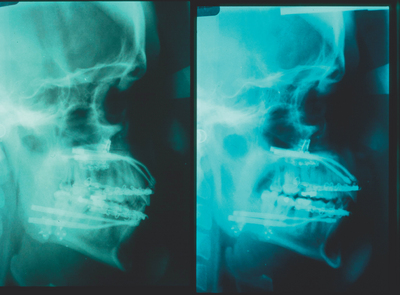Chapter 54 Distraction osteogenesis and obstructive sleep apnea syndrome
Maxillofacial skeletal deficiency in the sagittal and frontal plane has been shown to be a major contributing factor in obstructive sleep apnea syndrome (OSA). Despite the success of conventional surgical procedures in maxillofacial skeletal expansion, increasing interest has been generated in the use of distraction osteogenesis for skeletal expansion for the management of OSA. This chapter will discuss the method as well as relevant results.
1 INTRODUCTION
Maxillofacial skeletal abnormality is a well-recognized predictor in OSA. Maxillomandibular deficiency results in diminished airway dimension which leads to nocturnal obstruction.1,2 Currently, the most effective surgical procedure in the management of OSA is the expansion of facial skeleton by advancing the maxilla and mandible, i.e. maxillomandibular advancement (MMA). MMA achieves enlargement of the pharyngeal and hypopharyngeal airway by physically expanding the skeletal framework. In addition, the forward movement of the maxillomandibular complex improves the tension and collapsibility of the suprahyoid and velopharyngeal musculature. Lateral pharyngeal wall collapse, which has been shown to be a major factor in airway obstruction,3 is also shown to be lessened following MMA.4 The current MMA technique involves the use of maxillary Le Fort I osteotomy and mandibular sagittal split osteotomy to facilitate the forward movement of the maxillomandibular complex followed by the application of rigid fixation.5
Since the early recognition of the role of maxillofacial skeletal deformity in OSA, all of the emphasis of deformity recognition and treatment has been primarily limited to the sagittal plane. The transverse deficiency of the maxilla and/or mandible as a potential contributor and treatment of OSA has received little attention. Recently, the constriction of the maxilla has been suggested as a possible risk factor of OSA. In a comparative study between OSA and control subjects by Seto et al.,6 OSA subjects were found to have narrower, more tapered and shorter maxillary arches. Kushida et al.7 found that the intermolar distance of the maxilla is related to the presence of OSA. Cistulli et al.8 have reported that patients with Marfan’s syndrome, in which maxillary constriction is a common finding, have increased incidence of OSA and elevated nasal resistance. The relationship of nasal resistance and maxillary morphology has long been suggested in the orthodontic literature.
2 DISTRACTION OSTEOGENESIS IN THEMAXILLOFACIAL REGION
Skeletal expansion by slow osseous distraction (distraction osteogenesis) is not new and has been previously studied extensively in orthopedic surgery. It has demonstrated acceptable feasibility, efficacy, safety, and reproducibility of its treatment results. In its simplest form, distraction osteogenesis (DO) describes the generation of new bone in the stretched fracture callus. A screw-driven appliance that is firmly attached to the bone fragments slowly pulls apart the cut/or fractured bony edges, and new bone can fill in the stretched callus tissue. DO was first described by Alessandro Codvilla in 1905, who first published the use of this technique in lengthening the long bone.9 However, it is Ilizarov who is credited with developing the current methods of DO.10 DO in the maxillofacial region was first investigated by Snyder et al.11 in the canine mandible. Karp et al.12 demonstrated that bone formation during DO in the maxillofacial region is similar to that of long bones, which is predominantly by intramembranous ossification. Surgical lengthening by DO in sagittal plane was first described by McCarthy, who reported on the application of DO of the human mandible in pediatric patients in 1992.13 The surgical expansion of the maxilla and mandible to increase the width by distraction osteogenesis was reported by Bell and Epker14 and Guerrero,15 respectively.
< div class='tao-gold-member'>
Stay updated, free dental videos. Join our Telegram channel

VIDEdental - Online dental courses



